
Life is very different when you walk through it.
—The Unlikely Pilgrimage of Harold Fry, by Rachel Joyce
What is it that makes a man leave his house to mail a letter one minute, and within an hour or two commit to a walk the length of England, without proper clothing or gear, without a phone, without a map or guidebook much of the way, and without checking in first at home?
Perhaps the notion of taking one step after another in the hopes of keeping a friend alive awakens the dormant hero and this is sufficient to inspire an “ordinary” man to attempt something “extraordinary.” That seems the case, anyway, for our hero in The Unlikely Pilgrimage of Harold Fry, who walks from Kingsbridge to Berwick-upon-Tweed, some 600 or so miles apart, in order that his friend, Queenie Hennessy, will keep living.
Along the way, he encounters a variety of people and interesting places. We thought it would be fun to look at some of the places Harold Fry passed through on his journey. We’ll do our best to keep the story’s secrets, but be warned, by nature of the points on a map, there are inevitable spoilers ahead.
Top 10 Places in The Unlikely Pilgrimage of Harold Fry
1. Kingsbridge
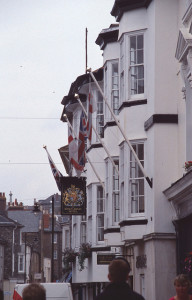
Built on a hill above Kingsbridge, the houses of Fossebridge Road enjoyed what real estate agents called an elevated position, with far-reaching views over the town and countryside. Their front gardens, however, sloped at a precarious angle toward the pavement below, and plants wrapped themselves round bamboo stakes as if hanging on for dear life.
The real Kingsbridge is a town in South Devon comprised of two medieval towns, Kingsbridge and Dodbrook. Considered the natural and historic center of the area, it originally developed as a market town for the monks of Buckfast Abbey.
2. South Brent

He was already different from the man who had set foot from Kingsbridge, and even from the small hotel. He was not someone off to the post box. He was walking to Queenie Hennessy. He was beginning again.”
South Brent calls itself “South Devon’s Best Kept Secret, ” a former woollen market center on the southern edge of Dartmoor that now hosts a variety of shops, pubs and cafes. Harold stopped in one of the small shops to purchase a toothbrush and razor (and plasters to care for his many-blistered feet). According to a woman Harold met at the hotel, South Brent gets more rain “than anywhere else in Devon.”
3. Buckfast Abbey
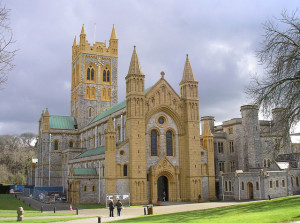
Again Harold left the phone booth, wishing he could make Maureen understand. But for years they had been in a place where language had no significance. She only had to look at him and she was wrenched to the past. Small words were exchanged and they were safe. They hovered over the surface of what could never be said, because that was unfathomable and would never be bridged.
Buckfast Abbey is a thousand-year-old monastery in the Benedictine tradition which features three gardens, lodging, a conference center and gift shop. The monks maintain bee colonies and produce tonic wine. Harold had visited the abbey with his family years before, but his son had been disagreeable and they never got out of the car.
4. Exeter

He understood that in walking to atone for the mistakes he had made, it was also a journey to accept the strangeness of others. As a passerby, he was in a place where everything, not only the land, was open. People would feel free to talk, and he was free to listen. To carry a little of them as he went. He had neglected so many things that he owed this small piece of generosity to Queenie and the past.
A 2000-year-old city, Exeter grew out of the civilian settlement of Romans and the native Celtic Briton following the Roman occupation. The city went through various iterations under control of Danes, Normans and French, and was contested during the English Civil War in the 1640s. Local landmarks include St. Peter’s Cathedral and the Roman City Wall. There are underground passages thoughout the city that carried fresh water during medieval times.
5. Taunton
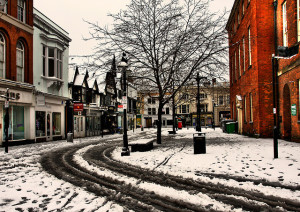
I admit it is an awfully long way to Berwick. I admit I am wearing the wrong clothes. And I also admit I have not the training, or the physique, for my walk. I cannot explain why I think I can get there, when all the odds are against it. But I do. Even when a big part of me is saying I should give up, I can’t. Even when I don’t want to keep going, I still do it.”
Taunton boasts beautiful meadows, rolling hills and lush dark woodlands. The rural area is cut by the Tone River and Bridgwater and Taunton Canal, with two working medieval water mills for exploring.
6. Bath
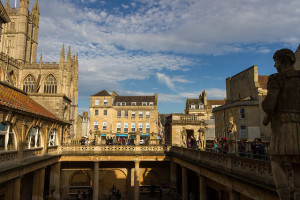
Beginnings could happen more than once, or in different ways. You could think you were starting something afresh, when actually what you were doing was carrying on as before. He had faced his shortcomings and overcome them, and so the real business of walking was happening only now.
Bath is considered to be among the most beautiful places in England and has drawn people to its hot springs and Roman baths for hundreds of years. Bath also features Bath Abbey and nearby Stonehenge. As part of his new beginning at Bath, Harold began to care for his body with gentle exercise and rest and learned the plants and their usefulness as he walked. “Once more, it surprised him how much was at his feet, if only he had known to look.”
7. Stratford-upon-Avon
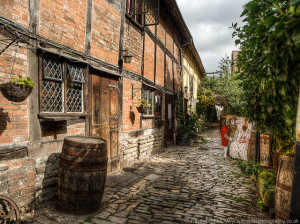
He saw that when a person becomes estranged from the things they know, and is a passerby, strange things take on a new significance. And knowing this, it seemed important to allow himself to be true to the instincts that made him Harold, as opposed to anyone else.
Stratford-upon-Avon, of course, is the birthplace of William Shakespeare, and while I will let slip that Harold did not visit any of the famous Shakespeare sites, if you were to pass through Stratford you could see the home where he was born, as well as his daughter’s home, his mother’s farm, and the Royal Shakespeare Theatre.
8. Darlington
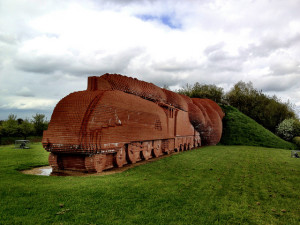
Tired and increasingly empty, he would stroll through the oncoming night while crickets creaked and stars pricked the sky. This was the only time he felt free, and connected. He thought of Maureen and Queenie. He remembered the past. Hours could pass and they would seem both like days and no time at all.
Darlington was an early Anglo-Saxon settlement on the River Skerne, with later Danish and Norman influence. The city features St. Cuthbert’s church, the “bonny church” of King James of Scotland’s 1603 poem, which is one of the largest churches in North East England, and is also home to a rich heritage of the railway. Darlington is situated near Croft, which Lewis Carroll considered home and where he did much of his writing.
9. Wooler
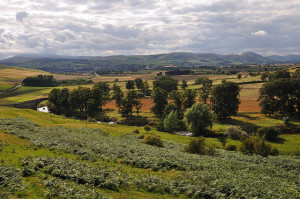
He tried to tell himself it was only a thing. She would understand. But all he could feel was the loss of its weight from his pocket, so vast its absence mounted to a presence. He feared that in mislaying the compass, he had also lost an essential, steadying part of himself.
Wooler is the gateway to the Cheviot Hills and sits on the edge of Northumberland National Park. The town is near Chillingham Castle, believed to be one of the most haunted in Britain.
10. Berwick-upon-Tweed
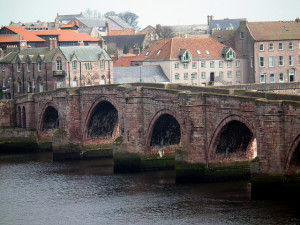
Part way through his journey to Berwick-upon-Tweed, Harold reflects on the ordinariness of being human, a theme that runs throughout the book:
He had learned that it was the smallness of people that filled him with wonder and tenderness, and the loneliness of that too. The world was made up of people putting one foot in front of the other; and a life might appear ordinary simply because the person living it had been doing so for a long time. Harold could no longer pass a stranger without acknowledging the truth that everyone was the same, and also unique; and that this was the dilemma of being human.
Featured photo by 白士 李. Location photos: Kingsbridge by Gerry Labrijn; South Brent by TheCameraGirls; Buckfast Abbey by Barry Lewis; Exeter by Hugh Llewelyn; Taunton by IDS.Photos; Bath by Lee; Stratford-upon-Avon by Trevor Wintle; Darlington by Paul; Wooler by David Biggins; Berwick-upon-Tweed by Plbmak. All Creative Commons license via Flickr. Post by LW Lindquist.
Buy The Unlikely Pilgrimage of Harold Fry
- Earth Song Poem Featured on The Slowdown!—Birds in Home Depot - February 7, 2023
- The Rapping in the Attic—Happy Holidays Fun Video! - December 21, 2022
- Video: Earth Song: A Nature Poems Experience—Enchanting! - December 6, 2022

L. L. Barkat says
I love this! And it’s so interesting, really, to think how he walked through all this “history” and yet the book focuses solely on his personal history. Thought-provoking juxtaposition.
These quotes remind me why I found this book to be so wonderful. What a great story. But more than that. Almost a parable.
Will Willingham says
I’ll be honest and say for much of the time I was reading, I wasn’t sure if the places were real. Because I’m not from England, of course, the names all sounded fanciful and at times made up. Berwick-upon-Tweed? Stratford should have been a clue, but it went right past me. 🙂
L. L. Barkat says
I think that sense of unreality actually may have also been spurred by the whole “parable” quality of the book. It was so real and yet so unreal. (I am wishing to spoil a certain mammal scene 😉 but I will hold back. I really do want to discuss all these parts of the book, too. We should set a one-day book club date! 🙂 )
Will Willingham says
It did have a sense of real and unreal woven together. The impossibility of the whole thing, coupled with believable details of the life of an ill-equipped man walking. There were times when I could smell Harold, which is a great accomplishment for the author. A bit of distress for me. 😉
Anna Blake Godbout says
It is very easy to over think and analyze each step that Harold takes. If one does that constantly, it takes away from the story. The answers are found in the sequel” The Love Song of Miss Queenie Hennessy. In Harold’s walk, there is awakening, regret and an unspoken sense of love as he walks through the cities and villages in England. And through it all, he is a quiet hero to us all and wishing for a moment we had the fortitude he has. An ordinary man doing an extraordinary thing which was in the end so ordinary for him.
Will Willingham says
Fortitude is a good word for it, especially considering all the things stacked against him. And yet, he persevered. Quite remarkable, really.
I think you’re right, that taking it as the whole and not each step really makes the story. (But I couldn’t help wanting him to get himself better equipped along the way. 🙂
Anna Blake Godbout says
Reading Harold’s story, there is our human logic that we want him to be better equipped to do such an endeavor. But that is the beauty of the story. Harold accomplished this without fancy tech equipment and expensive hiking gear. There would not be much of a story if he planned it all out before hand. A simple Englishman on a simple walk with the simplest of things. At his age, he does not care about such luxuries. His conflicts deep within himself and the external ones he encounters blend into who he truly is despite what his life has been. But it is something he finally has control over and defies what others think finally.
Megan Willome says
I had not given much thought to the places either, except for the couple I’d heard of.
L.L.’s comment makes me think that there is some corollary between a place’s history and a person’s. There’s always more there there.
L. L. Barkat says
Yes….
So what does it say that he moves from place to place? Does it mean a collecting (or a connecting with) of the whole of England’s history, on some strange level?
And I keep thinking… is Harold, on his walk, the quintessential Zen guy (the walk, the road, the Now) or the quintessential modern man (disconnected from past, not rooted)? If he is the second, there seems to be a statement that that is not really possible. We are still all one and our histories are one—each person important, connected to us, even as we are isolated from them culturally, spatially, or in time.
Will Willingham says
I think there’s surely a connection between the person and the place’s history. Even the cultural (and geographic) differences between your place as a Texan and Laura’s from the Northeast and mine as a Midwesterner. All other things being equal, none of our lives and experiences would have been the same had we lived in one of the other’s places. I forget, though, when I think about people and that their history is quite different from mine by virtue of where they’ve lived. I am as guilty as anyone else for seeing everyone though my own lens.
Sandra Heska King says
Oh my goodness, I love this. I’ve got to read this ASAP. Especially if there’s a book club date ahead. And it makes me want to walk more. Maybe I should walk to my hometown. It’s only a couple hundred miles. Or at least into Charlotte. It’s only 5 miles.
I’m glad you are all part of my history now.
Diana Trautwein says
Fabulous, LW. I loved the book and never even thought about mapping it out – somehow, it makes all of it more poignant to know where he actually went. Thank you!
PeeWee says
Did anyone think of the Odyssey at/near the beginning?